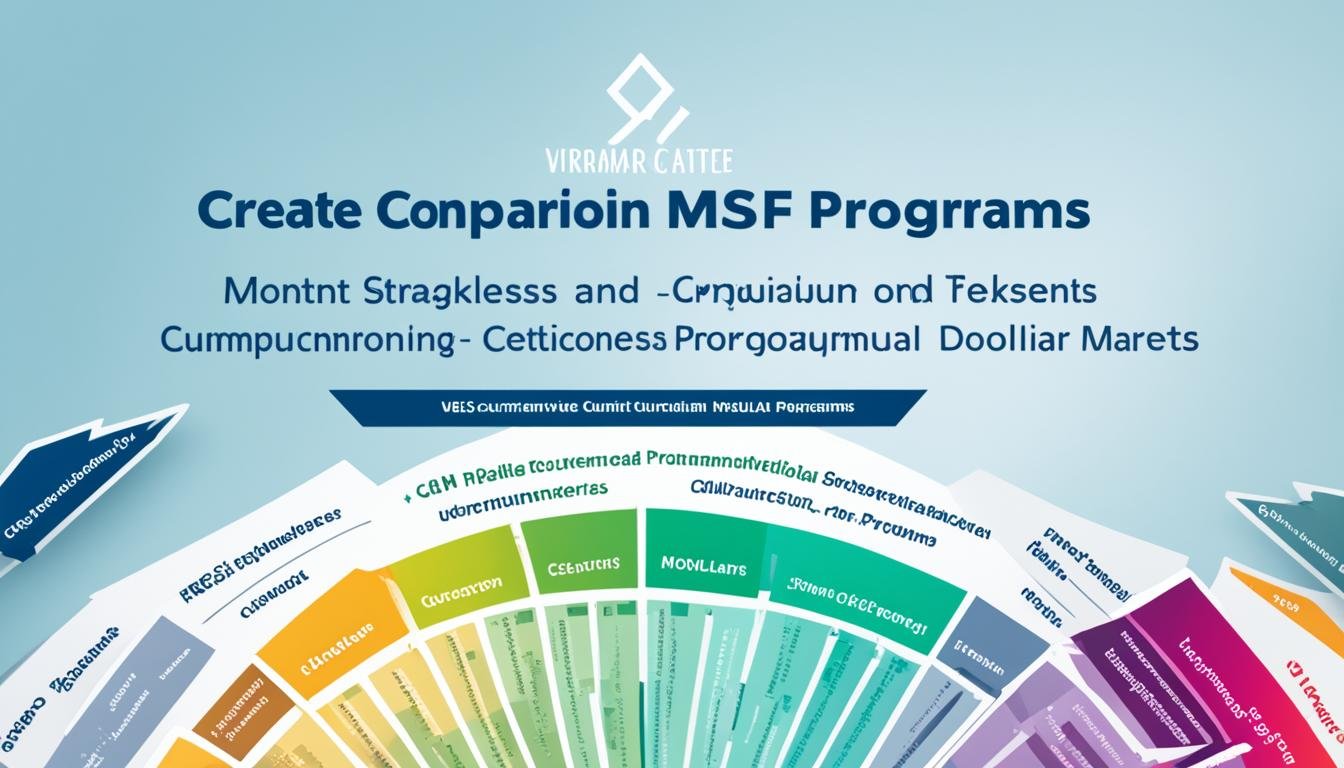Review of Master of Science in Risk and Finance (MSRF) Programs
Have you heard about the Master of Science in Risk and Finance (MSRF) Programs? They are well respected in the finance and risk management world. These programs give students a deep education. This helps them start great careers in finance. In this article, we will dive into the MSRF Programs. We’ll compare them, rank them, and give insights. This should help you choose the best for your education.
Key Takeaways:
- MSRF Programs are highly regarded in the field of finance and risk management.
- We will provide a comprehensive review of the MSRF Programs, including rankings, comparisons, and insights.
- These programs offer a comprehensive education to prepare students for successful careers in finance.
- Our review aims to help you make an informed decision about your education.
Overview of MSRF Programs
The Master of Science in Risk and Finance (MSRF) Programs dive into finance, risk management, and analysis.
Students often finish the program in 18 months. They get a deep look into financial markets and how to assess risks. There’s also a faster 12-month option for those who want to speed things up.
Getting into the MSRF Programs is tough. You need good grades and work experience. The schools look at your whole self, not just your grades.
The program’s courses are a mix of different fields. They teach students how to deal with changes in finance and risk every day.
Curriculum
The courses cover finance, risk, and stats. Students can also pick electives in areas they find interesting, like investment or engineering.
Projects and simulations help students learn practical skills. The program is all about mixing theory with hands-on experience.
Duration
Most students finish in 18 months. But, there’s also a quicker 12-month option available. This faster track covers everything the longer one does, more quickly.
Admissions Process
Getting in is hard. Schools look at your grades, work history, and what you could bring to the program.
You have to send in a bunch of stuff with your application. This includes your grades, a resume, and letters of recommendation. Some schools also want test scores.
If they like your application, you might get an interview. This is a chance to show why you’d be a great fit for the program.
The whole point is to find curious, hard-working people who love finance and risk. Schools want students who can really add something to the program.
Please note that the image provided above is for illustrative purposes only and does not depict any specific program or institution.
Class Size and Demographics
The MSRF Programs expect about 120 students each year. This number creates a vibrant place for learning. Students get to work with many others from different backgrounds. This makes learning more interesting and interactive.
These programs focus a lot on being diverse. There are students from everywhere, bringing their own stories and views. This makes the study rich and helps students think globally.
Diversity is key in the MSRF Programs. It shows students different ways to see risk and finance. Their varied backgrounds make learning about finance more complete.
Student Demographics
Students in the MSRF Programs come from varied fields like finance, math, and computer science. This mix shows the programs are open to all kinds of learners.
People from many parts of the world join these programs. They learn a lot from each other. This prepares them well for finance jobs worldwide.
“The MSRF Programs’ mix of students helps us learn about global finance. Talking with people from different places opens our minds. It prepares us for complex finance issues in a global world.” – John Smith, MSRF alumnus
The MSRF Programs’ dedication to diversity enhances education. It better equips students for their finance and risk management careers. This approach stands out in the field for its inclusiveness.
Program Schedule and Workload
The Master of Science in Risk and Finance (MSRF) Programs are known for their intense schedule. Students have between four to six classes every week. This means a lot of time dedicated to learning.
These programs focus on teaching advanced financial theories, math models, and industry standards. They use a STEM-based method to sharpen students’ analytical and problem-solving abilities. These skills are crucial for jobs in finance and risk management.
Even though students can choose some of their courses, the workload is heavy. With tough classes, lots of homework, and big projects, students stay busy. They work hard to succeed in their careers later on
Here’s a simple breakdown of what the program expects from students:
| Component | Details |
|---|---|
| Classes per Week | 4 to 6 |
| Coursework | Advanced financial theories, quantitative models, and industry practices |
| Flexibility | Some flexibility in course selection |
The MSRF Programs are a deep dive into the world of finance. They offer an enriching but demanding experience. This prepares graduates well for the challenges they’ll face in their financial careers.
MSRF Program vs. Chartered Financial Analyst (CFA) Program
The MSRF Program and the CFA Program are different in several ways. They focus on different areas of finance and have different study formats.
The CFA Program is all about investment management. It teaches you how to analyze investments and manage portfolios. The MSRF Program, however, gives a broader overview. It covers risk management, quantitative analysis, and financial modeling.
The MSRF Program goes into more detail than the CFA Program. It covers advanced financial theories and the latest in risk management. This program is great if you want a deep understanding and advanced skills in finance.
The CFA Program lets you study from anywhere, as it’s online. In contrast, the MSRF Program is on-campus. This means you learn with others face-to-face. You get to network, collaborate, and discuss finance topics in real-time with experts and peers.
Both programs offer a strong finance education but in different ways. The MSRF Program is perfect for a thorough finance education. The CFA Program is better for those focusing on investment management.
Key Differences: MSRF Program vs. CFA Program
- Focus: MSRF Program readies students for many finance jobs, while CFA Program specializes in investment management.
- Depth: MSRF Program gives an in-depth understanding, including advanced financial theories and risk management practices.
- Learning Format: MSRF Program is an in-person, on-campus experience, while CFA Program is online.
| Comparison | MSRF Program | CFA Program |
|---|---|---|
| Focus | Prepares students for various finance functions | Primarily focuses on investment management |
| Depth | Offers more in-depth learning | Provides a comprehensive understanding of investment analysis and portfolio management |
| Learning Format | Residential program with immersive on-campus experience | Distance learning program |
MSRF Program vs. Finance-Focused MBA
Choosing between a Master of Science in Risk and Finance (MSRF) and a finance-focused MBA from MIT Sloan is key. Your career goals and what you want to specialize in matter a lot. Both programs are strong in finance but their focus and what they teach are different.
The MSRF Program is perfect for early professionals wanting a deep finance program. It focuses on courses in risk management, finance analysis, and models. Graduates are ready for jobs needing serious financial know-how.
A finance-focused MBA at MIT Sloan is more general. It covers finance, strategy, leadership, and marketing. This wider degree helps in many finance jobs and others needing business management skills.
The MSRF Program gives specific risk and finance skills. An MBA offers general management knowledge, which is great for leadership or varied career paths. Think about your long-term career to choose wisely.
The Benefits of MSRF Program Specialization
Specializing in the MSRF Program sharpens your financial and risk skills. Focus is on understanding financial theories and managing risks through data. This makes you a top pick in finance jobs.
The program also offers projects to solve real finance challenges. This hands-on work sharpens your practical and problem-solving skills.
The Value of Finance-Focused MBA General Management Skills
A finance MBA teaches a wide range of management skills. It gives you a holistic view of business challenges. This skill is crucial for leading in today’s business world.
Its broad education helps tackle complex business issues. It prepares you to lead in changing and challenging times.
Comparative Overview
| Aspect | MSRF Program | Finance-Focused MBA |
|---|---|---|
| Focus | Specialized finance and risk management | General management skills with a finance emphasis |
| Curriculum | Quantitative courses, risk management, financial analysis | Finance, strategy, leadership, marketing |
| Career Opportunities | Specialized finance roles, risk management positions | Finance, consulting, general management |
| Long-Term Career Outlook | Deep expertise in risk and finance | Broad skill set, potential for diverse career paths |
The right pick between the MSRF Program and finance MBA depends on your goals and what you want to do. Both programs have a lot to offer for success in finance. Think about what you want in your career to make the right choice.
Career Services and Internship Opportunities
As part of the MSRF Program, students get help with finding jobs and internships. They work with career advisors who know about jobs in finance and risk. Through this program, students can find internships and full-time jobs.
The advisors help students improve their resumes and learn how to interview better. They also teach students how to network. They share what’s new in the job market and help students meet people who can advise them.
The MSRF Program is linked with MIT and its community. This connection lets students network with many people and find job opportunities. Students can use MIT’s resources to learn more about their career options and meet important employers.
Internships in the program allow students to work in real finance and risk settings. This hands-on experience helps them understand the industry better. They can use what they’ve learned in their classes in a practical way.
Thanks to the MSRF Program, students are ready to start their careers in finance and risk. They learn through real-world experiences and make connections in the industry. This helps them stand out when applying for jobs.
Testimonial
“The career services in the MSRF Program were key to my job search. The advisors helped me with my resume and interviews, and I got to meet industry pros. With their help, I landed an internship at a top finance firm, which led to a job. I’m so grateful for the program’s support.” – Sarah Thompson, MSRF Program graduate
Internship Placement Statistics
| Year | % of Students | Top Industry Employers |
|---|---|---|
| 2020 | 85% | Goldman Sachs, JPMorgan Chase, BlackRock |
| 2019 | 82% | Morgan Stanley, Citigroup, Barclays |
| 2018 | 87% | Bank of America, UBS, Credit Suisse |
Program Duration and Start Date
The Master of Science in Risk and Finance (MSRF) Program lasts either 18 or 12 months, depending on your needs. It starts on July 1st with a mandatory summer term. This term focuses on courses about finance theory and financial math.
If you choose the 18-month option, you’ll explore many topics deeply. These include quantitative analysis, risk management, and financial modeling. This duration gives you the time to understand these fields well.
There’s also a 12-month option for faster completion. It’s for students already strong in finance and math. Here, the program is condensed, letting you learn quickly and start your career earlier.
No matter how long you choose to study, the MSRF Program aims for a full educational experience. It combines theory and real-world skills to prepare you for the finance industry.
Summer Term: Intensive Finance Courses
The summer term focuses on finance’s core ideas and math. This first step is critical for the whole program.
Students will learn a lot about investment, derivatives, and more. The courses give them the tools to understand complex markets and make smart choices.
Summer classes are very important. They get students ready for the program’s challenges. These intense courses help students begin their finance journey with strong knowledge.
The MSRF Program mixes a full curriculum with flexible timing and a summer full of finance basics. This balanced approach gives every student a solid finance education. It’s designed to help students thrive in the fast-changing world of risk and finance.
Action Learning Opportunities and Concentrations
The MSRF Program gives students chances for hands-on learning. They solve real finance problems, moving from theories to practical skills. This bridges the gap and gets them ready for the finance world.
Finance Lab
The Finance Lab is top-notch, filled with advanced tech and software for financial work. Students deal with real case studies and solve tough financial issues. This lab helps them get a feel for the real pace and challenges of finance.
Finance Proseminars
In the Finance Proseminars, professionals and faculty lead talks on various finance topics. Students discuss and learn from industry experts. These seminars improve their critical and analytical thinking, key for success in finance.
Concentrations
The MSRF Program lets students focus on areas like risk management or corporate finance. This deep dive helps students become experts in their desired finance field. Choosing a concentration shapes their program to meet their career path dreams.
Students can take part in Action Learning or choose a concentration. The MSRF Program is a rich learning place that gets them ready for finance’s exciting changes.
Conclusion
The Master of Science in Risk and Finance (MSRF) Programs give students a deep education. They focus on finance, risk management, and more. This helps students prepare for jobs in the finance industry.
These Programs also help students find jobs. They offer career advice and let students connect with companies. At MIT Sloan, students can find many job opportunities.
Students also get to learn through real-world projects. They can specialize in their finance studies. This is done through the Finance Lab and other hands-on projects.
Overall, the MSRF Programs are great for starting a career in finance. The teaching, job support, and real-world learning experiences are very valuable. They prepare students well for the finance and risk management world.








